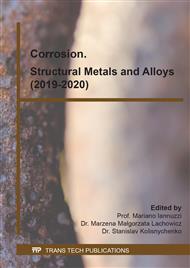[1]
O. Jonas, L. Machemer, Steam turbine corrosion and deposits problems and solutions, Proceedings of the Thirty-seventh Turbomachinery Symposium (2008) 211-228.
Google Scholar
[2]
G. C. JIAO, Analysis of stress corrosion cracking and safety assessment for blade groove of nuclear low-pressure turbine rotor, Shanghai Jiao Tong University (2015).
Google Scholar
[3]
X. Liu, Y. X. Zhong, Q. X. Ma, C. L. Yuan, Development of low-pressure rotor technology for nuclear steam turbine, China Metal Forming Equipment & Manufacturing Technology 44 (2009) 13-18.
Google Scholar
[4]
S. A. Shipilov, Solving some key failure analysis problems using advanced methods for materials testing, Engineering Failure Analysis 14 (2007) 1550-1573.
DOI: 10.1016/j.engfailanal.2006.12.003
Google Scholar
[5]
J. G. Parker, M. A. Sadler, Stress corrosion cracking of a low alloy steel in high purity steam, Corrosion Science 1 (1975) 57-63.
DOI: 10.1016/s0010-938x(75)80029-1
Google Scholar
[6]
D. A. Rosario, R. Viswanathan, C. H. Wells, G. J. Licina, Stress corrosion cracking of steam turbine rotors, Corrosion 54 (1998) 531-545.
DOI: 10.5006/1.3284881
Google Scholar
[7]
A. Turnbull, S. Zhou, Pit to crack transition in stress corrosion cracking of a steam turbine disc steel, Corrosion Science 5 (2004) 1239-1264.
DOI: 10.1016/j.corsci.2003.09.017
Google Scholar
[8]
R. M. Magdowski, M. O. Speidel, Clean steels for steam turbine rotors-their stress corrosion cracking resistance, Metallurgical Transactions A 19 (1988) 1583-1596.
DOI: 10.1007/bf02674033
Google Scholar
[9]
S. Holdsworth, M. Nougaret, B. Roberts, et al. Laboratory stress corrosion cracking experience in steam disc steel, Proceedings of the EPRI Steam Turbine Stress Corrosion Cracking Workshop (1997).
DOI: 10.1016/j.corsci.2003.09.017
Google Scholar
[10]
M. Banaszkiewicz, A. Rehmus-Forc, Stress corrosion cracking of a 60 MW steam turbine rotor, Engineering Failure Analysis 51 (2015) 55-68.
DOI: 10.1016/j.engfailanal.2015.02.015
Google Scholar
[11]
H. Itoh, Strength dependence of intergranular stress corrosion cracking susceptibility on 3.5% NiCrMoV steel at 403K, Material Science Research International 10 (2004) 34-40.
DOI: 10.2472/jsms.53.3appendix_34
Google Scholar
[12]
P. Wang, X. Huo, Y. M. Ding, An overview on development of welding rotor technology in nuclear turbines, Thermal Turbine 44 (2015) 296-299.
Google Scholar
[13]
J. J. Luo, Moisture-removal and corrosive-proof technology of AP1000 nuclear steam turbines, Thermal Turbine 43 (2014) 265-268.
Google Scholar
[14]
H. S. Fang, D. Y. Liu, P. G. Xu, B. Z. Bai, Z. G. Yang, The ways to improve strength and toughness of bainitic steel, Materials for Mechanical Engineering 25 (2001) 1-5.
Google Scholar
[15]
J. P. Xie, Y. Li, S. Q. Wang, Q. Zhang, Impact of chemical composition on uniform corrosion performance of stainless steel in 5% H2SO4 solution, Foundry Technology (2017) 823-825.
Google Scholar



